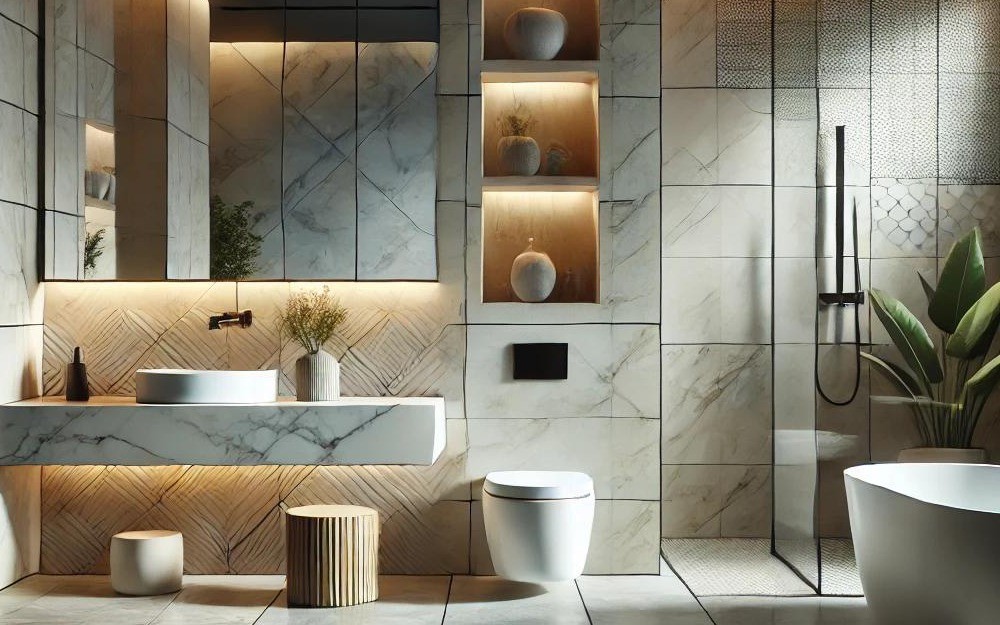What is ceramics?

Ceramic Material Varieties and Their Effects in Interior Design
Ceramics are central to interior design, contributing both aesthetically and functionally. The variety of textures, colors, patterns, and forms available enables designers to meet a wide range of stylistic and functional needs. Ceramics have a significant impact on the ambiance of a space, shaping the character of the surfaces they cover.
A. Technical Characteristics of Ceramic Types
-
Porcelain Ceramics: These have a low water absorption rate and a dense, durable structure. Porcelain is ideal for both flooring and wall applications, especially in high-traffic areas.
-
Glazed Ceramics: These feature a protective glazed surface, which makes them resistant to stains and chemicals. Available in both glossy and matte finishes, they are versatile in various applications.
-
Full-Body Ceramics: The color and design run through the entire thickness of the material, providing high wear resistance and durability.
-
Anti-Slip Ceramics: These have textured surfaces that enhance safety, particularly in wet areas like bathrooms and kitchens.
B. Aesthetic and Form Characteristics of Ceramic Types
-
Large-Format Ceramics: These minimize grout lines and create a seamless, spacious feel in modern interiors.
-
Mosaic Ceramics: Made from small tiles, mosaics offer decorative and artistic surfaces, commonly used in bathrooms and kitchens.
-
Natural Stone-Look Ceramics: These ceramics mimic textures of natural stones like marble, granite, and travertine, adding a sophisticated touch to classical and luxury designs.
-
Wood-Look Ceramics: Combining the warmth and texture of wood with the durability of ceramics, these are used in rustic, Scandinavian, and modern interiors.
-
Concrete and Metal-Look Ceramics: Perfect for industrial and loft-style designs, these ceramics create a contemporary and robust atmosphere.
The Effect of Ceramics on Interior Decoration
-
Enhancing Spatial Perception: Light-colored and large-format ceramics make small spaces appear more expansive and open, while dark colors and patterned surfaces add depth to a room.
-
Light Reflection and Texture Impact: Glossy ceramics reflect light, making spaces feel brighter, while matte and textured surfaces offer a more refined and natural appearance.
-
Functionality and Comfort: Ceramic surfaces are hygienic and easy to clean, making them ideal for high-use areas like kitchens and bathrooms.
-
Defining Style: The choice of ceramics significantly influences the overall style of a space. Natural stone or wood-like ceramics create a warm, inviting atmosphere, while geometric patterns and metallic finishes provide a modern and innovative feel.
Correctly selected ceramics bring both aesthetics and functionality together, enhancing the identity of a space. Surface texture, color, and pattern choices directly influence the ambiance of a room, making ceramics an essential complement to architectural design.
Ceramics in Wet Areas
Ceramics used in wet areas such as bathrooms, kitchens, and pools should meet specific criteria to ensure safety, durability, and aesthetics:
-
Slip Resistance (R Class): To avoid slippery surfaces, ceramics with a high slip resistance rating (R10-R13) are recommended for wet areas.
-
Water Absorption Rate: Ceramics with a low water absorption rate (less than 0.5%) should be used to prevent water from seeping into the material and compromising durability.
-
Chemical and Moisture Resistance: The ceramics should be resistant to detergents, soaps, and cleaning chemicals. Moisture-resistant surfaces that prevent mold and bacteria growth are preferable.
-
Surface Texture and Cleanability: Smooth, easy-to-clean, and stain-resistant ceramics ensure hygiene. Matte or slightly textured surfaces offer both aesthetic and practical benefits.
-
Durability and Abrasion Resistance: Ceramics with high hardness and abrasion resistance (PEI class 3-5) are suitable for areas with high foot traffic or frequent use.
-
Grout Selection: Grout used in wet areas should be waterproof and resistant to mold. Epoxy-based grouts offer better resistance to water and chemicals.
These qualities ensure that ceramic surfaces in wet areas remain safe, durable, and visually appealing.
Ceramic Sizes and Grout: A Balance of Aesthetics and Functionality
The size of the ceramics and the grout used have a direct impact on surface integrity, spatial perception, and long-term usability. Larger ceramics typically require fewer grout lines, creating a more seamless appearance, while smaller tiles result in more grout joints.
1. Large-Format Ceramics and Grout
Advantages:
-
Fewer Grout Joints: Large tiles minimize grout lines, offering a more cohesive and expansive look, ideal for modern or minimalist designs.
-
Easy to Clean: Fewer grout joints reduce the risk of dirt and water buildup, promoting hygiene.
-
Increased Spatial Perception: Large ceramics make a space feel larger and more open.
Disadvantages:
-
Sensitivity to Floor Movement: Fewer grout joints may result in less flexibility, causing cracks over time due to shifts in the underlying floor.
-
Installation Difficulty: Larger tiles require precision during installation to ensure they fit properly.
-
Visible Grout Lines: If grout color isn’t chosen carefully, visible grout lines can disrupt the desired seamless effect.
2. Small-Format Ceramics and Grout
Advantages:
-
Adaptability to Movement: Smaller tiles offer more grout joints, providing flexibility and preventing cracking due to floor movement.
-
Detailed Design: Small tiles allow for more intricate and artistic designs, particularly with mosaic patterns.
Disadvantages:
-
More Grout Lines: More grout joints can lead to higher maintenance, as they may collect dirt or water and become harder to clean.
-
Hygiene Concerns: Smaller tiles are more susceptible to mold, mildew, and stain formation. Antibacterial and waterproof grout should be used.
-
Visual Fragmentation: Excessive grout lines may break up the surface, making the space feel smaller or cluttered.
3. Grout Width and Color Selection
-
Narrow Grout Lines (1-2 mm): Preferred for large tiles, narrow grout lines create a more unified surface.
-
Wide Grout Lines (3-5 mm or more): Suitable for smaller tiles, wide grout lines provide flexibility for surface movement but can be harder to clean.
Grout Color:
-
Matching Grout: When the grout color matches the ceramic, it creates a uniform, minimalist look.
-
Contrasting Grout: Using a contrasting grout color emphasizes patterns and adds a decorative element to
